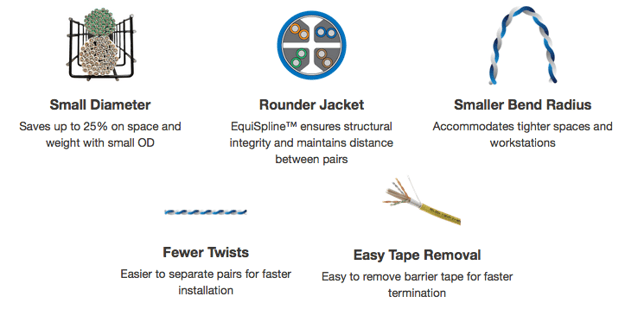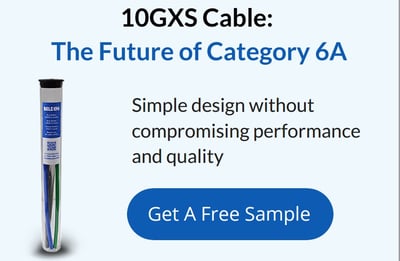Between emerging applications and industry adopted standards, telecomm and datacomm installations are continually in flux trying to future proof for the needs of tomorrow. When the first generation of category 6A cabling was first making waves in the late 2000's, the promise of additional bandwidth and longer run distance had to be weighed by the significant disadvantages brought to the table - bigger, heavier, and more delicate due to large bend radii. With the introduction of their new 10GXS Cat 6A cable, however, Belden has created a line that is far beyond both industry standards, and the competition. Lets take a look at what sets the 10GXS cable apart from others on the market.
1. Cable size and weight
Category 6A operates at frequencies up to 500 MHz -- twice that of Category 6. Controlling noise and crosstalk at higher frequencies has required Category 6A cables up to 50% larger than their category 6 predecessors. Larger size means fewer cables can fit into a cable tray or conduit, which is a huge concern in retrofit installations. While many available Category 6A options remain significantly larger and heavier, the newest category 6A cables are only about 15 percent larger than Category 6.
2. Bend radius
With larger cable diameters also comes a larger bend radius, which is important when routing cables in tight spaces such as inside wall cavities. The bend radius also has an impact on the ability to route cables for maximum airflow within racks. The smaller the bend radius, the easier the cable is to route and install.
3. Installation complexity
Most Category 6A cables are larger because they have more and thicker materials: more twists in the copper pairs, larger splines separating the pairs, and thicker outer jackets. All of these add up to cables that take longer to prepare and terminate. Thinner and more round cables take less time to install.
4. Power delivery
In a conventionally designed cable, the spline and jacket surrounding each copper pair create an insulated compartment that is prone to high heating when delivering power-over-Ethernet. Newer thermal-barrier designs distribute heat around the circumference of the cable, eliminating hotpots and some are capable of delivering up to 100W PoE while keeping thermal rise within acceptable limits.
5. Channel length
Some small-diameter Category 6A cables may not support the full 100 m distance per-channel, especially when delivering PoE, and need to be de-rated to less than full length. A cable that can handle the full 100 meters not only provides an extra margin of performance, but supports a wider range of data center configurations, including top-of-rack, end-of-row and middle-of-row configurations.
6. EMI shielding
There is a perception that shielded cable provides better noise immunity, but the effectiveness of the shield depends on the quality and reliability of the shield termination, balance of the twisted pairs, and quality of the local and remote ground connections. The impedance of the ground connection can increase at higher frequencies and differences in ground potential can couple noise into the conductors. Cable designs that effectively surround the conductors with a Faraday cage can provide an electromagnetic barrier without the potential drawbacks of grounding.
Belden 10GX System: Where Design and Performance Come Together
Belden’s Category 6A 10GX System overcomes the traditional drawbacks and compromises associated with Category 6A installation and use. The system has been specifically designed to support the mission-critical needs of data centers, server farms, storage area networks, and campus backbones or network access nodes. For a free sample of this next-gen Cat 6A cable, click here, or on the image below:
For more information on the 10GXS, or for any other inquiries, contact your local Accu-Tech representative today!




.png?width=58&height=58&name=X_logo_2023_(white).png)
